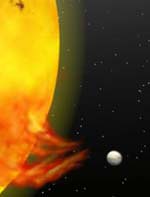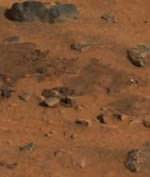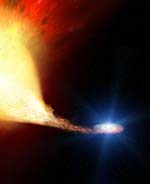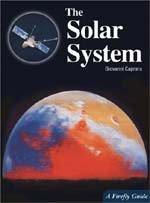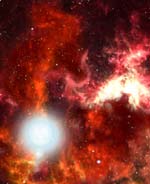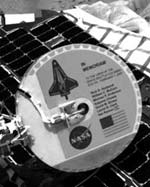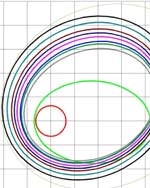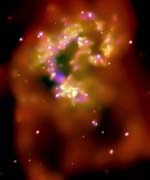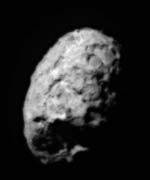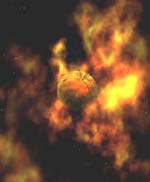
Image credit: NASA
A team of astronomers were lucky enough to observe the rare event of a neutron star turning into a magnetic object called a magnetar. Ten magnetars have been seen to date, but this object, a transient magnetar, is brand new. A normal neutron star is the rapidly spinning remnant of a star that went supernova; they typically possess a very strong magnetic field. A magnetar is similar, but it has a magnetic field up to 1,000 times as strong as a neutron star. This new discovery could indicate that magnetars are more common in the Universe than previously thought.
In a lucky observation, scientists say they have discovered a neutron star in the act of changing into a rare class of extremely magnetic objects called magnetars. No such event has been witnessed definitively until now. This discovery marks only the tenth confirmed magnetar ever found and the first transient magnetar.
The transient nature of this object, discovered in July 2003 with NASA’s Rossi X-ray Timing Explorer, may ultimately fill in important gaps in neutron star evolution. Dr. Alaa Ibrahim of George Washington University and NASA Goddard Space Flight Center in Greenbelt, Md., presents this result today at the meeting of the American Astronomical Society in Atlanta.
A neutron star is the core remains of a star at least eight times more massive than the Sun that exploded in a supernova event. Neutron stars are highly compact, highly magnetic, fast-spinning objects with about a Sun’s worth of mass compressed into a sphere roughly ten miles in diameter.
A magnetar is up to a thousand times more magnetic than ordinary neutron stars. At a hundred trillion (10^14) Gauss, they are so magnetic that they could strip a credit card clean at a distance of 100,000 miles. The Earth’s magnetic field, in comparison, is about 0.5 Gauss, and a strong refrigerator magnet is about 100 Gauss. Magnetars are brighter in X rays than they are in visible light, and they are the only stars known that shine predominantly by magnetic power.
The observation presented today supports the theory that some neutron stars are born with these ultrahigh magnetic fields, but they may be at first too dim to see and measure. In time, however, these magnetic fields act to slow the neutron star’s spin. This act of slowing releases energy, making the star brighter. Additional disturbances in the star’s magnetic field and crust can make it brighter yet, leading to the measurement of its magnetic field. The newly discovered star, dim as recent as a year ago, is named XTE J1810-197.
“The discovery of this source came courtesy of another magnetar that we were monitoring, named SGR 1806-20,” said Ibrahim. He and his colleagues detected XTE J1810-197 with the Rossi Explorer about a degree to the northeast of SGR 1806-20, within the Milky Way galaxy about 15,000 light years away in the constellation Sagittarius.
Scientists pinpointed the location of the source with NASA’s Chandra X-ray Observatory, which provides more accurate positioning than Rossi. Checking archive data from the Rossi Explorer, Dr. Craig Markwardt of NASA Goddard estimated that XTE J1810-197 became active (that is, 100 times brighter than before) around January 2003. Looking back even further with archived data from ASCA and ROSAT, two decommissioned international satellites, the team could spot XTE J1810-197 as a very dim, isolated neutron star as early as 1990. Thus, the history of XTE J1810-197 emerged.
The inactive state of XTE J1810-197, Ibrahim said, was similar to that of other puzzling objects called Compact Central Objects (CCOs) and Dim Isolated Neutron Stars (DINSs). These objects are thought to be neutron stars created in the hearts of star explosions, and some still reside there, but they are too dim to study in detail.
One mark of a neutron star is its magnetic field. But to measure this, scientists need to know the neutron star’s spin period and the rate that it is slowing down, called the “spin down”. When XTE J1810-197 lit up, the team could measure its spin (1 revolution per 5 seconds, typical of magnetars), its spin down, and thus its magnetic field strength (300 trillion Gauss).
In the alphabet soup of neutron stars, there are also Anomalous X-ray Pulsars (AXPs) and Soft Gamma-ray Repeaters (SGRs). Both of these are now considered to be the same kind of objects, magnetars; and another presentation at today’s meeting by Dr. Peter Woods et al. supports this connection. These objects periodically but unpredictably erupt with X-ray and gamma-ray light. CCOs and DINSs appear not to have a similar active state.
Although the concept is still speculative, an evolutionary pattern may be emerging, Ibrahim said. The same neutron star, endowed with an ultrahigh magnetic field, may pass through each of these four phases during its lifetime. The proper order, however, remains unclear. “Discussion of such a pattern has surfaced in the scientific community in recent years, and XTE J1810-197’s transient nature provides the first tangible evidence in favor of such a kinship,” Ibrahim said. “With a few more examples of stars showing a similar trend, a magnetar family tree may emerge.”
“The observation implies that magnetars could be more common than what is seen but exist in a prolonged dim state,” said team member Dr. Jean Swank of NASA Goddard.
“Magnetars seem now to be in a perpetual carnival mode; SGRs are turning into AXPs and AXPs can start behaving like SGRs anytime and without warning,” said team member Dr. Chryssa Kouveliotou of NASA Marshall, who is receiving the Rossi Award at the AAS meeting for her work on magnetars. “What started with a few odd sources, may soon be proven to encompass a huge number of objects in our Galaxy.”
Additional supporting data came from the Interplanetary Network and the Russian-Turkish Optical Telescope. Ibrahim’s colleagues on this observation also include Dr. William Parke of George Washington University; Drs. Scott Ransom, Mallory Roberts and Vicky Kaspi of McGill University; Dr. Peter Woods of NASA Marshall; Dr. Samar Safi-Harb of the University of Manitoba; Dr. Solen Balman of the Middle East Technical University in Ankara; and Dr. Kevin Hurley of University of California at Berkeley. Drs. Eric Gotthelf and Jules Halpern of Columbia University provided important data from Chandra.
Original Source: NASA News Release

